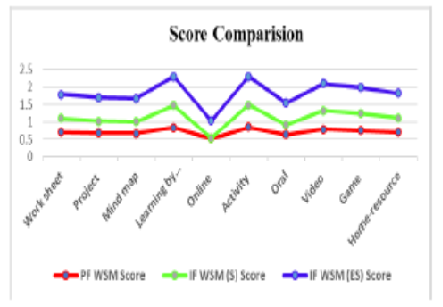


Indian Journal of Science and Technology
DOI: 10.17485/IJST/v16i38.1545
Year: 2023, Volume: 16, Issue: 38, Pages: 3168-3176
Original Article
M Kavitha1*, R Irene Hepzibah1
1PG & Research Department of Mathematics, T.B.M.L. College (Affiliated to Bharathidasan University), Porayar, Tamil Nadu, India
*Corresponding Author
Email: [email protected]
Received Date:22 June 2023, Accepted Date:01 September 2023, Published Date:09 October 2023
Objectives: Students’ progress is determined by their learning style. The goal of this research is to use survey data to develop a new framework for the Pythagorean fuzzy number in order to establish the best learning strategy. Methods: An inventive method for translating the questionnaire’s crisp results to Pythagorean Fuzzy numbers. A new MATLAB algorithm for converting Crisp data to Pythagorean Fuzzy data was also created. The Pythagorean Fuzzy WSM is used to determine the most effective learning approach. It is also opposed with the Intuitionistic Fuzzy WSM approach. Findings: The procedure for evaluating and prioritizing strategies, as well as selecting the most efficient method. PFWSM received a score of 0.84254. According to the findings of this study, the most effective technique is activity-based learning. Except for two learning techniques, the rank determined in PFWSM will vary in all comparisons IFWSM (S), IFWSM (ES) to the rank of score. Novelty: This research presents a novel way for assessing survey questionnaire data on a Pythagorean fuzzy background. A new MATLAB algorithm for computing Pythagorean fuzzy numbers obtained from survey replies and PFWSM Ranking. This novel approach for converting survey responses to Pythagorean fuzzy type can be applied to any sort of survey.
Keywords: Pythagorean Fuzzy; Ranking; Respondent; MATLAB; WSM; Learning approach; Fuzzification
© 2023 Kavitha & Hepzibah. This is an open-access article distributed under the terms of the Creative Commons Attribution License, which permits unrestricted use, distribution, and reproduction in any medium, provided the original author and source are credited. Published By Indian Society for Education and Environment (iSee)
Subscribe now for latest articles and news.